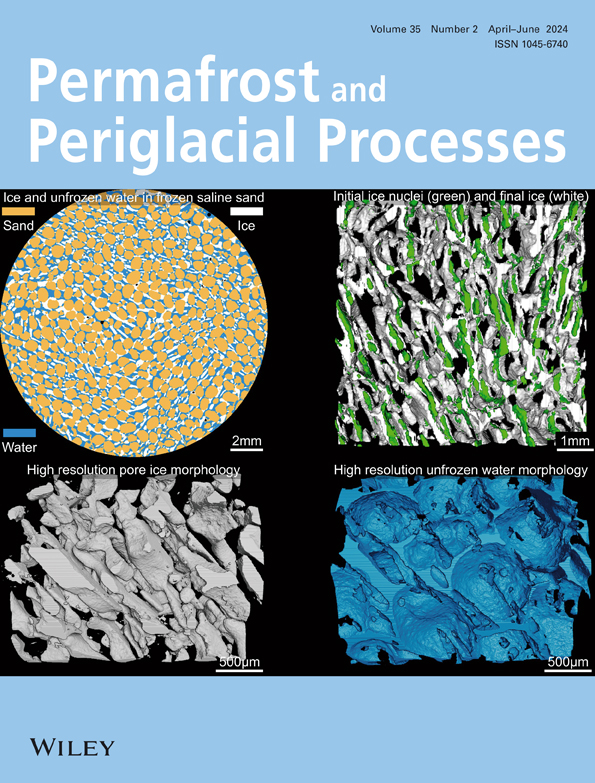西格陵兰岛陡坡上冰楔多边形的稳定性与活动层的温度和水分动力学有关
IF 3.3
3区 地球科学
Q2 GEOGRAPHY, PHYSICAL
引用次数: 0
摘要
陡坡上的冰楔多边形一般被描述为被冰缘沉积物覆盖,通常,斜坡上的活动层在解冻期间变得可移动,这可能导致溶蚀。而在靠近冰缘的西格陵兰岛,尽管活动层和冰楔多边形出现在坡度≥30°的陡坡上,但它们是稳定的。从2009年到2015年,我们在Umimmalissuaq山谷进行了土壤调查(包括土壤分析和放射性碳测年),并在当前冰缘以东约4 km处安装了一个野外观测站,以监测冰楔形中间陡峭的朝北斜坡上活动层10、20和35 cm深度的土壤温度和水张力。解冻和冻结期持续2至3个月,活动层通常在11月至次年4月完全冻结。我们在一个夏季的1天内,在活动层的所有三个深度同时观测到完全的水饱和。在夏季融雪期间,即使在坡度大于30°的情况下,活动层的水量显然不足以引发溶蚀。此外,茂密的灌木苔原在解冻和冻结之间的时期吸收了大部分的水,这进一步稳定了边坡。这一过程,加上由降风引起的干燥和大陆性气候,加上没有或有限的冻胀,在决定这些斜坡的稳定性方面起着至关重要的作用,并可以解释在大约5000年前富含有机质的永久冻土中存在的大规模稳定冰楔多边形网络。这项研究强调了土壤水动力学和当地气候制度对景观稳定性的重要性,以及在地貌梯度强和气温上升的地区,不同强度的溶蚀过程。本文章由计算机程序翻译,如有差异,请以英文原文为准。
Ice wedge polygon stability on steep slopes in West Greenland related to temperature and moisture dynamics of the active layer
Ice wedge polygons on steep slopes have generally been described as being covered by periglacial sediments and, typically, the active layer on slopes becomes mobile during thaw periods, which can lead to solifluction. In West Greenland close to the ice margin, however, the active layer and ice wedge polygons are stable despite their occurrence on steep slopes with inclinations of ≥30°. We conducted a soil survey (including sampling for soil analyses and radiocarbon dating) in the Umimmalissuaq valley and installed a field station ~4 km east of the current ice margin to monitor soil temperature and water tension at depths of 10, 20 and 35 cm of the active layer on a steep, north‐facing slope in the middle of an ice wedge polygon from 2009 to 2015. Thawing and freezing periods lasted between 2 and 3 months and the active layer was usually completely frozen from November to April. We observed simultaneous and complete water saturation at all three depths of the active layer in one summer for 1 day. The amount of water in the active layer apparently was not enough to trigger solifluction during the summer thaw, even at slope inclinations above 30°. In addition, the dense shrub tundra absorbs most of the water during periods between thawing and freezing, which further stabilizes the slope. This process, together with the dry and continental climate caused by katabatic winds combined with no or limited frost heave, plays a crucial role in determining the stability of these slopes and can explain the presence of large‐scale stable ice wedge polygon networks in organic matter‐rich permafrost, which is about 5,000 years old. This study underlines the importance of soil hydrodynamics and local climate regime for landscape stability and differing intensities of solifluction processes in areas with strong geomorphological gradients and rising air temperatures.
求助全文
通过发布文献求助,成功后即可免费获取论文全文。
去求助
来源期刊
CiteScore
9.70
自引率
8.00%
发文量
43
审稿时长
>12 weeks
期刊介绍:
Permafrost and Periglacial Processes is an international journal dedicated to the rapid publication of scientific and technical papers concerned with earth surface cryogenic processes, landforms and sediments present in a variety of (Sub) Arctic, Antarctic and High Mountain environments. It provides an efficient vehicle of communication amongst those with an interest in the cold, non-glacial geosciences. The focus is on (1) original research based on geomorphological, hydrological, sedimentological, geotechnical and engineering aspects of these areas and (2) original research carried out upon relict features where the objective has been to reconstruct the nature of the processes and/or palaeoenvironments which gave rise to these features, as opposed to purely stratigraphical considerations. The journal also publishes short communications, reviews, discussions and book reviews. The high scientific standard, interdisciplinary character and worldwide representation of PPP are maintained by regional editorial support and a rigorous refereeing system.

 求助内容:
求助内容: 应助结果提醒方式:
应助结果提醒方式:


